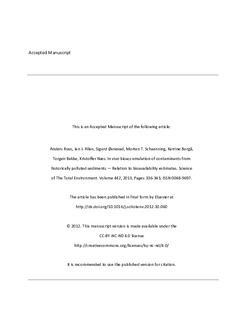| dc.contributor.author | Ruus, Anders | |
| dc.contributor.author | Allan, Ian | |
| dc.contributor.author | Øxnevad, Sigurd | |
| dc.contributor.author | Schaanning, Morten | |
| dc.contributor.author | Borgå, Katrine | |
| dc.contributor.author | Bakke, Torgeir Heggelund | |
| dc.contributor.author | Næs, Kristoffer | |
| dc.date.accessioned | 2018-10-05T07:54:01Z | |
| dc.date.available | 2018-10-05T07:54:01Z | |
| dc.date.created | 2013-06-15T15:10:14Z | |
| dc.date.issued | 2013 | |
| dc.identifier.citation | Science of the Total Environment. 2013, 442, 336-343. | nb_NO |
| dc.identifier.issn | 0048-9697 | |
| dc.identifier.uri | http://hdl.handle.net/11250/2566572 | |
| dc.description.abstract | Many contaminants are recalcitrant against degradation. Therefore, when primary sources have been discontinued, contaminated sediments often function as important secondary pollution sources. Since the management and potential remediation of contaminated marine sediments may be very costly, it is important that the environmental risks of contaminants present in these sediments and benefits of remediation are evaluated as accurately as possible. The objective of this study was to evaluate the bioavailability of common organochlorine contaminants and polycyclic aromatic hydrocarbons (PAHs) in selected polluted sediments from Norway by simple generic sorption models (free energy relationships), as well as by pore water concentration measurements. Furthermore, the aim was to predict bioaccumulation from these bioavailability estimates for comparison with in vivo bioaccumulation assessments using ragworm (Nereis virens) and netted dogwhelk (Hinia reticulata). Predicted biota-to-sediment accumulation factors (BSAFs) derived from pore water concentration estimates were in better agreement with the bioaccumulation observed in the test organisms, than the generic BSAFs expected based on linear sorption models. The results therefore support that site-specific evaluations of bioaccumulation provide useful information for more accurate risk assessments. A need for increased knowledge of the specific characteristics of benthic organisms, which may influence the exposure, uptake and elimination of contaminants, is however emphasized. | nb_NO |
| dc.language.iso | eng | nb_NO |
| dc.publisher | Elsevier | nb_NO |
| dc.rights | Attribution-NonCommercial-NoDerivatives 4.0 Internasjonal | * |
| dc.rights.uri | http://creativecommons.org/licenses/by-nc-nd/4.0/deed.no | * |
| dc.title | In vivo bioaccumulation of contaminants from historically polluted sediments - Relation to bioavailability estimates | nb_NO |
| dc.type | Journal article | nb_NO |
| dc.type | Peer reviewed | nb_NO |
| dc.description.version | acceptedVersion | nb_NO |
| dc.rights.holder | © 2012 Elsevier | nb_NO |
| dc.source.pagenumber | 336-343 | nb_NO |
| dc.source.volume | 442 | nb_NO |
| dc.source.journal | Science of the Total Environment | nb_NO |
| dc.identifier.doi | 10.1016/j.scitotenv.2012.10.060 | |
| dc.identifier.cristin | 1034421 | |
| dc.relation.project | Norges forskningsråd: 172531 | nb_NO |
| cristin.unitcode | 7464,20,12,0 | |
| cristin.unitcode | 7464,20,0,0 | |
| cristin.unitname | Marin forurensning | |
| cristin.unitname | Fagsenter for kyst- og havmiljø | |
| cristin.ispublished | true | |
| cristin.fulltext | postprint | |
| cristin.qualitycode | 2 | |

